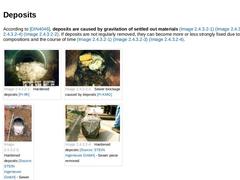
|
According to [DIN4046], deposits are caused by gravitation of settled out materials (Bild 2.3.2.1) (Bild 2.3.2.1) (Bild 2.3.2.1) (Bild 2.3.2.1). If deposits are not regularly removed, they can become more or less strongly fixed due to their compositions and the course of time (Bild 2.3.2.1) (Bild 2.3.2.1) (Bild 2.3.2.1). | (Image: Hardened deposits [FI-IfK]) | (Image: Sewer blockage caused by deposits [FI-KMG]) | | (Image: Hardened deposits - Sewer filled … |
|
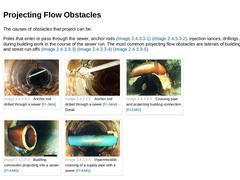
|
The causes of obstacles that project can be: Poles that enter or pass through the sewer, anchor rods (Bild 2.3.2.2) (Bild 2.3.2.2), injection lances, drillings, among others during building work in the course of the sewer run. The most common projecting flow obstacles are laterals of buildings, properties and street run-offs (Bild 2.3.2.2) (Bild 2.3.2.2) (Bild 2.3.2.2). |
(Image: Anchor rod drilled through a sewer [FI-Jtele])
|
(Image: Anchor rod drilled … |
|
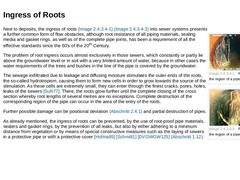
|
|
(Image: Root ingress in the region of a pipe joint [FI-KMG])
|
|
(Image: Root ingress in the region of a pipe joint [FI-IfK])
|
Next to deposits, the ingress of roots (Bild 2.3.2.3) (Bild 2.3.2.3) into sewer systems presents a further common form of flow obstacles, although root resistance of all piping materials, sealing media and gasket rings, as well as of the complete pipe joints, has been a requirement of all the effective standards since the … |
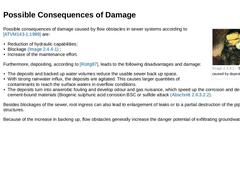
|
(Image: Sewer blockage caused by deposits [FI-KMG]) Possible consequences of damage caused by flow obstacles in sewer systems according to [ATVM143-1:1989] are: - Reduction of hydraulic capabilities;
- Blockage (Bild 2.3.3) ;
- Increase of the maintenance effort.
Furthermore, depositing, according to [Rüttg87], leads to the following disadvantages and damage: - The deposits and backed up water volumes reduce the usable sewer back up space.
- With strong rainwater …
|

|
|
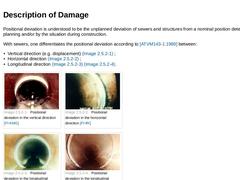
|
Positional deviation is understood to be the unplanned deviation of sewers and structures from a nominal position determined by planning and/or by the situation during construction. With sewers, one differentiates the positional deviation according to [ATVM143-1:1989] between: - Vertical direction (e.g. displacement) (Bild 2.4.1) ;
- Horizontal direction (Bild 2.4.1) ;
- Longitudinal direction (Bild 2.4.1) (Bild 2.4.1).
|
(Image: Positional deviation in the … |
|
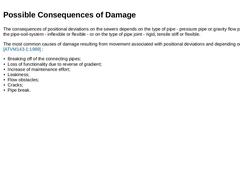
|
The consequences of positional deviations on the sewers depends on the type of pipe - pressure pipe or gravity flow pipe - and on the pipe-soil-system - inflexible or flexible - or on the type of pipe joint - rigid, tensile stiff or flexible. The most common causes of damage resulting from movement associated with positional deviations and depending on its extent are [ATVM143-1:1989] : - Breaking off of the connecting pipes;
- Loss of functionality due …
|

|
|
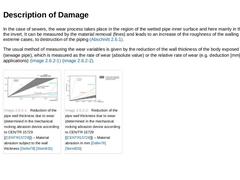
|
In the case of sewers, the wear process takes place in the region of the wetted pipe inner surface and here mainly in the region of the invert. It can be measured by the material removal (fines) and leads to an increase of the roughness of the walling and, in extreme cases, to destruction of the piping (Abschnitt 2.6.1). The usual method of measuring the wear variables is given by the reduction of the wall thickness of the body exposed to the wear (… |
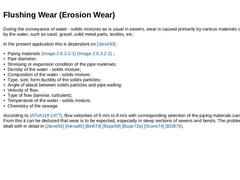
|
During the conveyance of water - solids mixtures as is usual in sewers, wear is caused primarily by various materials carried along by the water, such as sand, gravel, solid metal parts, textiles, etc. In the present application this is dependent on [Järve93] : - Piping materials (Bild 2.5.1) (Bild 2.5.1) ;
- Pipe diameter;
- Stressing or expansion condition of the pipe materials;
- Density of the water - solids mixture;
- Composition of the water - solids mixture;
|
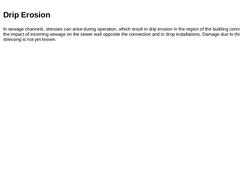
|
In sewage channels, stresses can arise during operation, which result in drip erosion in the region of the building connections due to the impact of incoming sewage on the sewer wall opposite the connection and in drop installations. Damage due to this type of stressing is not yet known. |
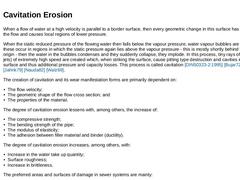
|
When a flow of water at a high velocity is parallel to a border surface, then every geometric change in this surface has a resultant on the flow and causes local regions of lower pressure. When the static reduced pressure of the flowing water then falls below the vapour pressure, water vapour bubbles are formed. If these occur in regions in which the static pressure again lies above the vapour pressure - this is mostly shortly behind the position … |
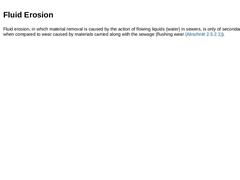
|
Fluid erosion, in which material removal is caused by the action of flowing liquids (water) in sewers, is only of secondary importance when compared to wear caused by materials carried along with the sewage (flushing wear (Abschnitt 2.5.2.1)). |
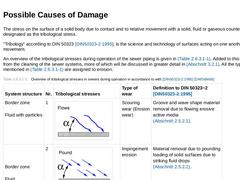
|
The stress on the surface of a solid body due to contact and to relative movement with a solid, fluid or gaseous counter body is designated as the tribological stress. "Tribology" according to DIN 50323 [DIN50323-2:1995], is the science and technology of surfaces acting on one another in relative movement. An overview of the tribological stresses during operation of the sewer piping is given in Tabelle 2.5.2. Added to this are stresses from the cleaning … |
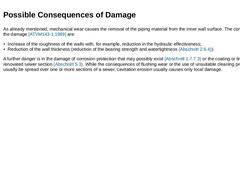
|
As already mentioned, mechanical wear causes the removal of the piping material from the inner wall surface. The consequences of the damage [ATVM143-1:1989] are: - Increase of the roughness of the walls with, for example, reduction in the hydraulic effectiveness;
- Reduction of the wall thickness (reduction of the bearing strength and watertightness (Abschnitt 2.6.4)).
A further danger is in the damage of corrosion protection that may possibly exist (… |
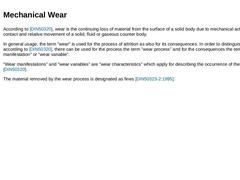
|
According to [DIN50320], wear is the continuing loss of material from the surface of a solid body due to mechanical action, i.e. contact and relative movement of a solid, fluid or gaseous counter body. In general usage, the term "wear" is used for the process of attrition as also for its consequences. In order to distinguish them, according to [DIN50320], there can be used for the process the term "wear process" and for the consequences the terms "… |
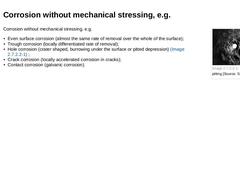
|
(Image: Hole corrosion - pitting) Corrosion without mechanical stressing, e.g. - Even surface corrosion (almost the same rate of removal over the whole of the surface);
- Trough corrosion (locally differentiated rate of removal);
- Hole corrosion (crater shaped, burrowing under the surface or pitted depression) (Bild 2.6.1.1) ;
- Crack corrosion (locally accelerated corrosion in cracks);
- Contact corrosion (galvanic corrosion).
|
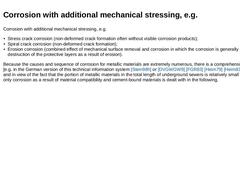
|
Corrosion with additional mechanical stressing, e.g. - Stress crack corrosion (non-deformed crack formation often without visible corrosion products);
- Spiral crack corrosion (non-deformed crack formation);
- Erosion corrosion (combined effect of mechanical surface removal and corrosion in which the corrosion is generally caused by the destruction of the protective layers as a result of erosion).
Because the causes and sequence of corrosion for metallic … |
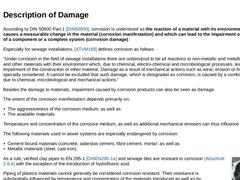
|
According to DIN 50900 Part 1 [DIN50900], corrosion is understood as the reaction of a material with its environment, which causes a measurable change in the material (corrosion manifestation) and which can lead to the impairment of the function of a component or a complete system (corrosion damage). Especially for sewage installations, [ATVM168] defines corrosion as follows: "Under corrosion in the field of sewage installations there are understood … |
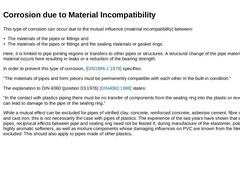
|
This type of corrosion can occur due to the mutual influence (material incompatibility) between: - The materials of the pipes or fittings and
- The materials of the pipes or fittings and the sealing materials or gasket rings.
Here, it is limited to pipe jointing regions or transfers to other pipes or structures. A structural change of the pipe material or sealing material occurs here resulting in leaks or a reduction of the bearing strength. |
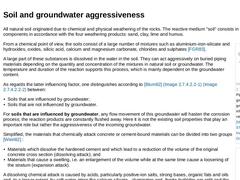
|
All natural soil originated due to chemical and physical weathering of the rocks. The reactive medium "soil" consists in its components in accordance with the four weathering products: sand, clay, lime and humus. | (Image: Pipe laying in the ground with ground water inflow with reference to [Irle84] [Image: S&P GmbH]) | | (Image: Pipe laying in the ground without ground water inflow with reference to [Irle84] [Image: S&P GmbH]) |
From a chemical point of … |
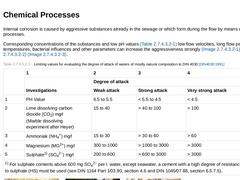
|
Internal corrosion is caused by aggressive substances already in the sewage or which form during the flow by means of chemical processes. Corresponding concentrations of the substances and low pH values (Tabelle 2.6.3.2.1) low flow velocities, long flow periods, high temperatures, bacterial influences and other parameters can increase the aggressiveness strongly (Bild 2.6.3.2.1) (Bild 2.6.3.2.1) (Bild 2.6.3.2.1). (Table: Limiting values for evaluating … |
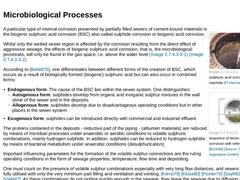
|
| (Image: Biogenic sulphuric acid corrosion in a manhole [FI-Hermea]) | | (Image: Principle of sequence of bionic sulphuric acid corrosion with reference to [Bock84] [Image: S&P GmbH]) |
A particular type of internal corrosion presented by partially filled sewers of cement-bound materials is the biogenic sulphuric acid corrosion (BSC) also called sulphide corrosion or biogenic acid corrosion. Whilst only the wetted sewer region is affected by the corrosion … |
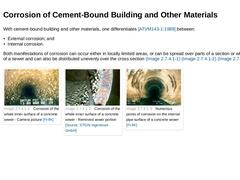
|
With cement-bound building and other materials, one differentiates [ATVM143-1:1989] between: - External corrosion; and
- Internal corrosion.
Both manifestations of corrosion can occur either in locally limited areas, or can be spread over parts of a section or whole sections of a sewer and can also be distributed unevenly over the cross section (Bild 2.6.3) (Bild 2.6.3) (Bild 2.6.3). |
(Image: Corrosion of the whole inner surface of a concrete sewer - Camera … |
|
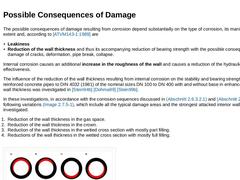
|
The possible consequences of damage resulting from corrosion depend substantially on the type of corrosion, its manifestation and extent and, according to [ATVM143-1:1989] are - Leakiness
- Reduction of the wall thickness and thus its accompanying reduction of bearing strength with the possible consequential damage of cracks, deformation, pipe break, collapse.
Internal corrosion causes an additional increase in the roughness of the wall and causes a reduction … |